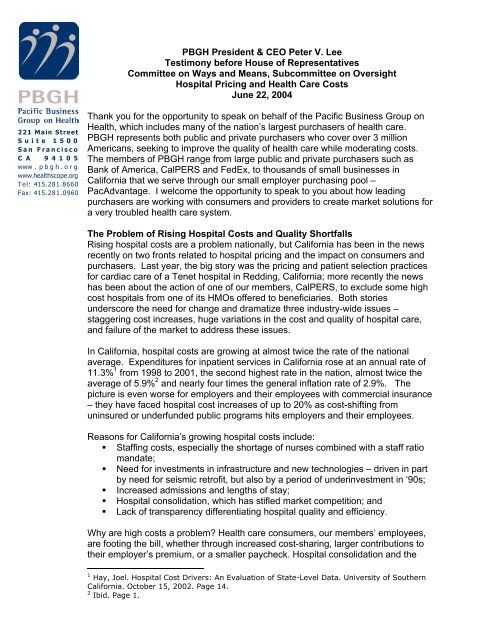PBGH President & CEO Peter V. Lee Testimony before - Consumer ...
PBGH President & CEO Peter V. Lee Testimony before - Consumer ...
PBGH President & CEO Peter V. Lee Testimony before - Consumer ...
- No tags were found...
You also want an ePaper? Increase the reach of your titles
YUMPU automatically turns print PDFs into web optimized ePapers that Google loves.
<strong>PBGH</strong> <strong>President</strong> & <strong>CEO</strong> <strong>Peter</strong> V. <strong>Lee</strong><strong>Testimony</strong> <strong>before</strong> House of RepresentativesCommittee on Ways and Means, Subcommittee on OversightHospital Pricing and Health Care CostsJune 22, 2004221 Main StreetSuite 1500San FranciscoC A 9 4 1 0 5www . p b g h . o r gwww.healthscope.orgTel: 415.281.8660Fax: 415.281.0960Thank you for the opportunity to speak on behalf of the Pacific Business Group onHealth, which includes many of the nation’s largest purchasers of health care.<strong>PBGH</strong> represents both public and private purchasers who cover over 3 millionAmericans, seeking to improve the quality of health care while moderating costs.The members of <strong>PBGH</strong> range from large public and private purchasers such asBank of America, CalPERS and FedEx, to thousands of small businesses inCalifornia that we serve through our small employer purchasing pool –PacAdvantage. I welcome the opportunity to speak to you about how leadingpurchasers are working with consumers and providers to create market solutions fora very troubled health care system.The Problem of Rising Hospital Costs and Quality ShortfallsRising hospital costs are a problem nationally, but California has been in the newsrecently on two fronts related to hospital pricing and the impact on consumers andpurchasers. Last year, the big story was the pricing and patient selection practicesfor cardiac care of a Tenet hospital in Redding, California; more recently the newshas been about the action of one of our members, CalPERS, to exclude some highcost hospitals from one of its HMOs offered to beneficiaries. Both storiesunderscore the need for change and dramatize three industry-wide issues –staggering cost increases, huge variations in the cost and quality of hospital care,and failure of the market to address these issues.In California, hospital costs are growing at almost twice the rate of the nationalaverage. Expenditures for inpatient services in California rose at an annual rate of11.3% 1 from 1998 to 2001, the second highest rate in the nation, almost twice theaverage of 5.9% 2 and nearly four times the general inflation rate of 2.9%. Thepicture is even worse for employers and their employees with commercial insurance– they have faced hospital cost increases of up to 20% as cost-shifting fromuninsured or underfunded public programs hits employers and their employees.Reasons for California’s growing hospital costs include:• Staffing costs, especially the shortage of nurses combined with a staff ratiomandate;• Need for investments in infrastructure and new technologies – driven in partby need for seismic retrofit, but also by a period of underinvestment in ‘90s;• Increased admissions and lengths of stay;• Hospital consolidation, which has stifled market competition; and• Lack of transparency differentiating hospital quality and efficiency.Why are high costs a problem? Health care consumers, our members’ employees,are footing the bill, whether through increased cost-sharing, larger contributions totheir employer’s premium, or a smaller paycheck. Hospital consolidation and the1 Hay, Joel. Hospital Cost Drivers: An Evaluation of State-Level Data. University of SouthernCalifornia. October 15, 2002. Page 14.2 Ibid. Page 1.
<strong>Testimony</strong> of <strong>Peter</strong> V. <strong>Lee</strong>June 22, 2004Page 2rapid acceleration of hospital cost trends not only impacts affordability, but access.Rising hospital costs drive a cycle of cost-shifting: as hospitals and doctors raiserates to recover the cost of unpaid or under-paid services. As we see cutbacks insupport for public programs, the commercial market picks up a disproportionateshare of hospital cost increases. Subsequent cost shifting onto premium-payingemployers and consumers accelerates a vicious, self-perpetuating cycle as largeemployers struggle to maintain comprehensive coverage and some small employersdrop coverage altogether, leading to higher rates of uninsured. Again, this isparticularly true in California, where Medi-Cal – our Medicaid program – has one ofthe lowest reimbursement rates in the nation.The problem is not just high cost – it is the variation in cost, and the fact that there isa total disconnect between cost and quality of care. We see variations between andwithin communities that defy a rational explanation and signal insufficientlycompetitive markets for hospital services. Gall bladder or heart surgery costs threetimes as much in Sacramento as in San Diego; Caesarian-section costs twice asmuch in Sacramento as in Los Angeles. 3We also see enormous cost variations within a single community. According to datacollected by the state and reported by HealthShare Technology – based on billedcharges: 4• The average charge in Sacramento (<strong>before</strong> insurer discount) for ahysterectomy ranges from $13,921 at the lowest-charging hospital to $43,931at the highest;• For gall bladder surgery, from $17,826 to $61,095;• For kidney transplant, from $115,096 to $184,183; and• For bypass surgery, from $131,735 to $225,678.And, there is no indication that these cost differences have any relation to differentlevels of quality of care. Wide cost variations reveal insufficient market competitionand the gap is just as large when we look at hospital quality:• A patient is about twice as likely to have a wound infected in the bottom 25%of hospitals as in the top 25%; 5 a similar likelihood exists for gettingpneumonia after surgery and other avoidable complications;• We now have a limited set of hospital outcomes data, such as for heartsurgery, which also shows wide variation in quality;• And we know that the extent to which hospitals have in place systems toavoid medical errors, such as having adequate intensivist coverage inintensive care units or computer physician order entry, varies dramaticallyand is generally insufficient.<strong>Consumer</strong>s and purchasers need—and are beginning to demand—transparent costand quality information on individual hospitals and doctors. We want to know whosecare leads to better clinical outcomes. We want to know whose care leads to how3 Rapaport, Lisa. Region feels pain of high hospital bills. Sacramento Bee. November 10, 2002.4 Sacramento Hospital Comparison: Full Year 2000 Inpatient Data. HealthShare Technology,Inc. November 14, 2002.5 Kane, Nancy M. Siegrist, Richard B. Understanding Rising Hospital Impatient Costs: KeyComponents of Cost and the Impact of Poor Quality. August 12, 2002. Page 30
<strong>Testimony</strong> of <strong>Peter</strong> V. <strong>Lee</strong>June 22, 2004Page 3much total spending for a hospital procedure or a year’s chronic illness care, andwhy. We need to be able to know when high hospital or physician fees enable lowertotal health insurance spending over an episode or year of illness and when theymerely “pile on” or exacerbate higher total health insurance spending.Solving the problem of hospital cost and quality variation will require participation byall parties. Hospitals and physicians must embrace a culture of accountability inwhich their payable charges, “longitudinal efficiency” with respect to total healthinsurance spending, and quality are transparent to consumers. Purchasers mustcreate an environment where hospitals compete on and are paid for performanceexcellence.The Market is Failing to Assure Excellence by Hospitals and PhysiciansLarge employers and consumer organizations agree with the Institute of Medicine’sreports in 1998, 1999 and 2001 that there is a wide gap between the health care thatAmericans are getting and what health care could and should be. The followingfigure summarizes current research and expert opinion on the approximatepercentage point size of the gap.Large employers also agree with the Institute of Medicine that closing the gaprequires that purchasers and insurers correct serious flaws in the market for doctorand hospital services via two actions: (1) creating precise streams of publicperformance measurement of doctors and hospitals; and (2) rewarding doctor andhospital excellence via performance-based payment; and/or insurance plan designswhich encourage consumer selection of better performing providers.To accelerate these two foundations of a market solution to weak health careindustry performance, large American employers launched two linked “procompetitive”initiatives: the <strong>Consumer</strong> and Purchaser Disclosure Project (“theDisclosure Project”); and the Leapfrog Group.
<strong>Testimony</strong> of <strong>Peter</strong> V. <strong>Lee</strong>June 22, 2004Page 4The Disclosure Project is an informal partnership of large employers, businesscoalitions and consumer advocacy and labor that includes AARP, General Motors,Motorola, the Pacific Business Group on Health, the AFL-CIO, the Employer HealthCare Alliance Cooperative (“The Alliance”) in Madison, WI, the American BenefitsCouncil, and the National Partnership for Women and Families. These groups sharea commitment to health care performance accountability and the Disclosure Project’sgoal that “by January 1, 2007, Americans will be able to select hospitals, physicians,integrated delivery systems and treatments based on public reporting of nationallystandardized performance measures for clinical quality, patient experience, equityand efficiency.”The Disclosure Project is promoting the National Quality Forum’s (NQF) multistakeholderconsensus process to define valid and feasible standardizedperformance measures and assure routine reporting by doctors and hospitals. IfNQF-mediated progress proves insufficient, Disclosure Project members arecommitted to pursuing other options for performance reporting. The personal andeconomic consequences for consumers and purchasers of continued performanceblindselection of hospitals, doctors and treatments have become intolerable.The Leapfrog Group is a private, non-profit organization of more than 130 ofAmerica’s largest private and public employers and unions that provide over $56billion in health benefits annually. Members commit to encouraging their employeesto select, and/or their insurers to reward, better-performing hospitals, doctors, andtreatment options. The “Frogs” initially focused on identifying and rewardinghospitals that excelled in three important patient safety features. The LeapfrogGroup is now expanding its focus beyond patient safety and aligning its marketrewards with doctor and hospital excellence across all of the performance domainsadvocated by the Disclosure Project.The Disclosure Project and the Leapfrog Group are creating the nationalgroundswell that is being translated into real first steps for both consumers andproviders. I heartily recommend MedPAC’s June report, which not only highlightsinnovative strategies undertaken by purchasers, but underscores how Medicare –like much of the private market – falls short by providing few incentives to providersor consumers; and does too little to encourage efficient delivery and organization ofcare.Solutions To Reforming the MarketPurchasers look to the health plans we contract with to ensure that hospitals are notbeing overpaid, are being rewarded for better performance, and to provide valid toolsso consumers can make better-informed choices. Nationally we should have thesame expectation of CMS in its administration of Medicare. And, the good news isthat in recent years we have seen CMS step up to this challenge in important ways.The four elements needed to promote higher quality and more efficient care deliveryin our nation’s hospitals are:
<strong>Testimony</strong> of <strong>Peter</strong> V. <strong>Lee</strong>June 22, 2004Page 51. Expand the Availability of Standardized Performance InformationWe currently have a Tower of Babel of conflicting and incomplete measures to reporton hospital performance. The path to resolve this problem is to support andaccelerate the National Quality Forum’s efforts to identify consensus performancestandards. Core funding for the National Quality Forum’s efforts should come fromthe federal government. At the same time, CMS should not only be applauded for itsfocus on the importance of performance transparency, but urged to accelerate itsefforts to insure that useable information on hospital and physician performance getsinto the hands of consumers, providers and purchasers.The National Quality Forum has endorsed 39 measures for hospital performance, aswell as a set of 30 patient safety practices. The National Quality Forum has alsoendorsed 15 nursing sensitive measures and 28 serious reportable events, such aswrong-site surgery. Ten of the NQF’s measures of hospital performance arecurrently being used for the National Voluntary Hospital Reporting Initiative (currentlyaddressing three conditions – heart failure, pneumonia and acute myocardialinfarction). States are also embracing these standards – lead by Minnesota, whichrequires all hospitals to publicly report on NQF’s serious reportable events.To move beyond the Tower of Babel we need to:(1) Rapidly adopt a standardized hospital patient experience survey and quicklyget H-CAHPS into the market – building on the independent good works doneby CMS and AHRQ;(2) Expand endorsed hospital measures that provide better global pictures ofhospital quality, such as surgical infection rates;(3) Develop standards for measuring the relative efficiency with which care isdelivered. While this hearing is titled “Hospital Pricing” – we need to getbeyond looking at mere unit price, to assess the full associated healthinsurance costs or “longitudinal efficiency” with which care by hospitals anddoctors is delivered. Such a measure would reflect not only the price chargedfor an admission or procedure, but also costs related to readmission,complications and post-hospital care; and(4) Make routinely available to the private sector, patient identity-encryptedversion of the full Medicare claims data base, so private health plans canmore precisely measure hospital and physician performance over longitudinalperiods of illness (which most private sector plans do not have sufficient datato do on their on).2. Reward Better Hospital PerformanceThere are large-scale pay for performance programs that are starting to change themarket by rewarding better performance of individual physicians and medicalgroups. The Integrated Healthcare Association’s pay-for-performance initiative inCalifornia brings together seven health plans with purchasers and over two hundredmedical groups – with an estimated $100 million in bonus payments based oncommon measures of clinical performance, patient experience and IT reengineering.Another example is the Bridges to Excellence program – a collaborative of nationalemployers and some health plans, that uses nationally standardized certification
<strong>Testimony</strong> of <strong>Peter</strong> V. <strong>Lee</strong>June 22, 2004Page 6projects from NCQA to reward better performing physicians in the areas of diabetesand cardiac care, as well as for their overall office practices.At the hospital level, the Leapfrog Group has lead the way in identifying betterperforming hospitals based on valid comparative information – these Leapfrogmeasures are increasingly one of the core elements of health plans’ efforts toinclude quality dimensions in hospital tiering or design of narrow networks – as hasbeen done by numerous health plans, such as Blue Shield of California, PacifiCareand Health Net.Nationally, CMS’s Premier Hospital Quality Incentive Demonstration is importantboth because it will reward hospitals based on their performance related to sixcommon and expensive conditions, but also it is setting the stage for sharing withconsumers information that they can and will use. The recent efforts of CMS point toa promising future if CMS continues to not only innovate and explore how best toreward higher value providers, but does so in concert with private and state-basedpublic purchasers.3. Provide Information and Incentives to <strong>Consumer</strong>sAcross the country there is a growing array of tools being provided to health careconsumers to help them make better choices. Many members of the PacificBusiness Group on Health, such as Wells Fargo, the University of California andIntel, provide their employees with health plan chooser tools. These tools helpconsumers weigh the financial impact of their choosing a particular plan – based ontheir likely health care utilization – along with physician availability information, andplan quality. In addition, many employers are looking to their health plans to providetools to help consumers choose and understand treatments.In the hospital arena, we are using first generation tools that give consumersinformation on how hospitals meet Leapfrog standards and provide other informationsuch as patient experience data, when available, or complication rates. At the sametime, CMS is testing how it can best convey comparative hospital performanceinformation to consumers. <strong>Consumer</strong>s want and need this information; our task is toensure that these tools provide valid reflections of hospitals’ performance – eitherglobally or by particular treatment.While we develop the full dashboard of performance information – purchasers mustbe working today to bring together cost and quality information for their employees.We cannot pretend that all hospitals are delivering the same performance.CalPERS, a member of <strong>PBGH</strong> and the third largest purchaser of health care in theUnited States, is continuing its leadership in health care by recently making thedecision to exclude 38 hospitals across California from their Blue Shield HMO basedon these facilities being substantially higher cost than comparable available hospitals– considering a dozen quality indicators in their determination. Through this action,CalPERS created a “virtual tiering” since beneficiaries that wanted these higher costhospitals could still get them through their PPO – but they would pay more.
<strong>Testimony</strong> of <strong>Peter</strong> V. <strong>Lee</strong>June 22, 2004Page 74. Allow the Market to FunctionFinally, we need to be sure that comparative performance information can indeed beused to help consumers make better choices and to reward better performinghospitals. There is a danger in many communities that hospital consolidation willhinder these efforts. Hospitals creating networks for their joint purchasing andnegotiating is fine IF those consolidations allow the market to work. A workingmarket means:• Allowing individual hospitals within a network to be priced differently, whetherthrough tiers or coinsurance. Conglomerates should not be able to preventseparate tiering by quality and efficiency;• Conglomerates of hospitals should not be able to use their market power toprevent health plans from using their data to better define higher valuehospitals;• Conglomerates of hospitals should not be able to set one rate for all of theirhospitals – different quality and cost should be able to show through; and• Conglomerates should not be able to require inclusion of all hospitals in theirnetwork as a condition for accessing any of them.Sadly, the examples of intensified market competition catalyzing hospitalperformance breakthrough remain the exception rather than the rule. For thoseAmericans fortunate enough to have health coverage, the vast majority are totallydisconnected from the true costs of care and are making life and death choices withvirtually no information. They have neither incentives nor information with which tomake better hospital choices. Similarly, hospitals – like other health care providers –are not recognized or rewarded if they deliver higher quality care more efficiently.We are still almost performance blind. The market’s invisible hand requiresstandardized performance information for hospitals across the six IOM performancedomains – safety, timeliness, effectiveness, efficiency, equity and patientcenteredness.The good news is that we are making progress and much of thecredit for this lies with CMS’ engaged commitment, demonstrated through their workwith the National Voluntary Hospital Reporting Initiative; developing the nationalstandard patient-experience survey – H-CAHPS; testing consumer presentations ofquality information; and promoting pay for performance demonstrations.Most consumers today don’t have the information to make informed decisions abouttreatments or providers. Most providers are paid the same whether they deliver thehighest quality or the lowest quality care, irrespective of their cost-effectiveness.The only solution to reforming health care over the long term is to change these twodynamics – consumers must have the information and incentives to make the bestchoices for them; and providers need to be rewarded for doing a better job. Thankyou for the opportunity to be with you today.




